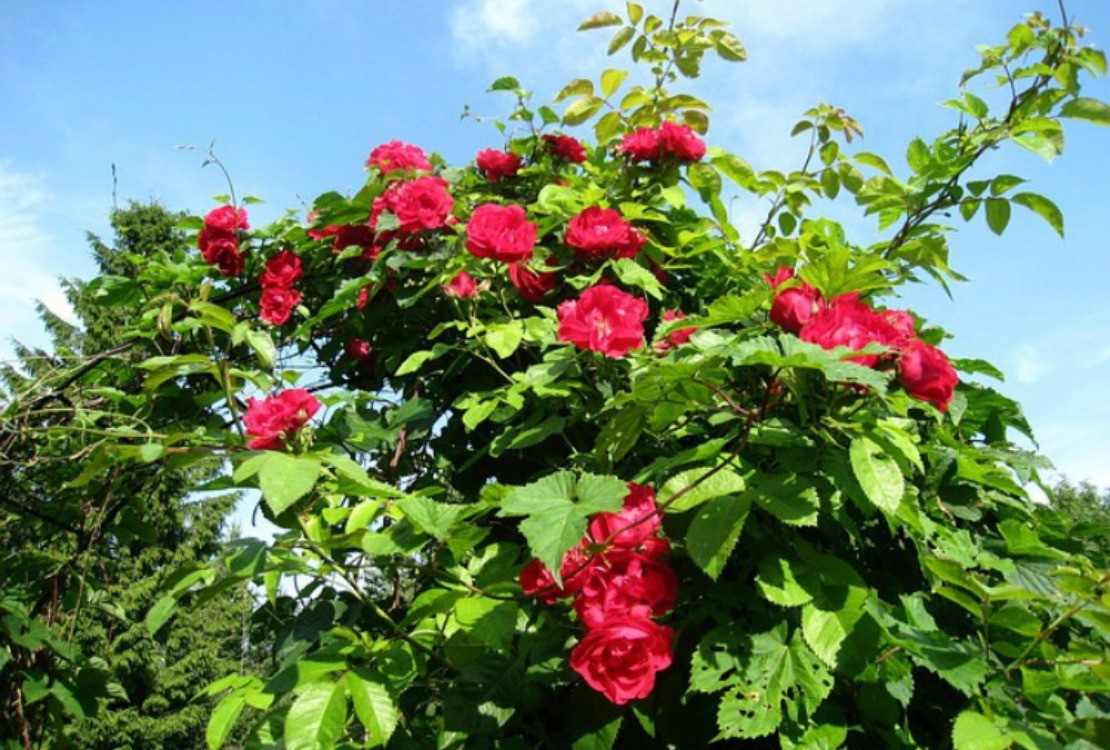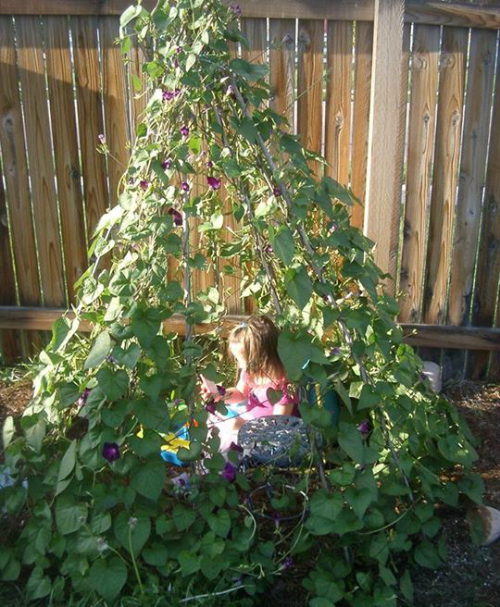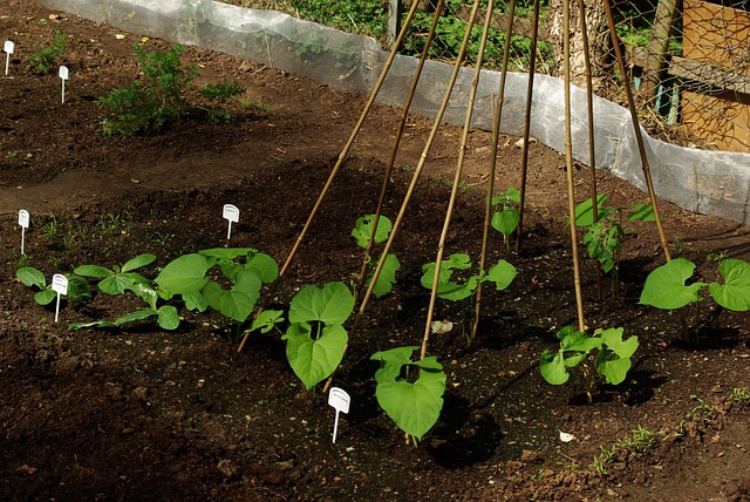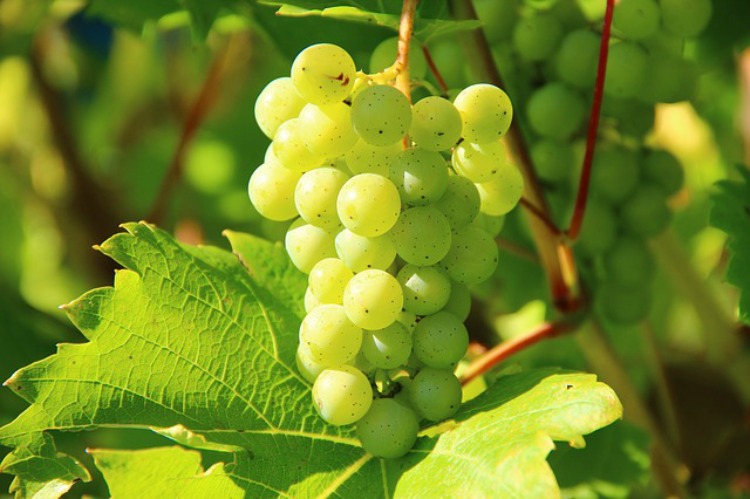
Plant A Magical Living Fort For Kids
A lush living fort covered in lovely plants creates a wonderful hideaway for children. It makes the perfect shady spot to spend a summer afternoon immersed in imagination or simply reading a good book. For a child, there isn’t anything that is much more fun than hanging out in a fort.
A living fort is not only a wonderful place for kids to play, it also provides ideal support for climbing plants. You can grow beautiful ornamental plants such as morning glories or black-eyed Susans on a living fort or you can invite some more useful members of the plant kingdom to grow on this whimsical form. From herbs that make wonderful remedies to vegetables and even fruits, a living fort can provide so much more than fun.
Plants For A Living Fort
If you want to create a simple, temporary living fort, choose from fast growing annual plants such as nasturtiums, scarlet runner beans or squash. For a more permanent structure, you can choose slow-growing perennial plants such as honeysuckle and rose. Consider planting a few of those fast growing annuals along side perennials to provide cover and interest while waiting for the perennials to grow.
Helpful Herbs For A Living Fort
Some herbs need a little support while they grow. Why not encourage them to grow on a beautiful living fort right in your own yard?
Nasturtium (Tropaeolum majus)
Annual
Nasturtium grows quickly from seed and needs to be supported as it grows. The bright, cheery peppery tasting flowers are high in vitamin C and the leaves are high in iron. The leaves make a nice addition to salads. As an herbal remedy spicy, warming nasturtium stimulates digestion and circulation. It helps the body to better absorb nutrients.
Honeysuckle (Lonicera caprifolium, L. periclymenum, L. japonica)
Perennial, Zone depends on species, generally 4 to 10
It is great fun to suck the sweet nectar of from these beautiful flowers. And believe it or not the incredibly fragrant honeysuckle finds use as an herbal remedy. The beautiful flowers are edible and along with the leaves can be helpful for infections of the respiratory and digestive tracts. Honeysuckle contains salicylic acid making it a helpful companion during times of pain. Be careful to plant an edible honeysuckle as some species are poisonous, and do not eat honeysuckle seeds.
Climbing Rose (Rosa species)
Perennial, Zone depends on species, generally 4 to 10
Beautiful and fragrant climbing roses are usually used to cover a garden arch or arbor. The flower petals are used to help cool down heat and inflammation in the body. They are also astringent helping to check bleeding and ease congestion. Rose petals are wonderful for cheering up a sad heart, too! The hips are high in nutrients, most notably vitamin C. Look for thornless climbing roses to keep little ones safe and happy.
Passionflower (Passiflora incarnata)
Perennial, Zone 5 to 9, hardy to 5 degrees fahrenheit
Passionflower has incredibly beautiful and interesting flowers. Passionflower is a wonderful nervine that helps to ease stress, soothe away spasms, and encourage sleep.
Jasmine (Jasminum officinale, J. grandiflorum)
Perennial, Zone 7 to 10
Jasmine is another plant that has highly fragrant flowers. We enjoy this wonderful plant inside our home because it is too cold here in Colorado for jasmine to grow outside. I can only imagine how amazing it would be to sit in a fort covered with jasmine flowers! Jasmine has found use in helping to sooth the nerves and ease the emotions. It is astringent and antiseptic properties can be helpful for respiratory infections and as a topical wash for skin issues.
Tasty Vegetables & Fruits
Can you imagine playing with friends while surrounded by your lunch?
Scarlet Runner Beans (Phaseolus coccineus) plus a variety of cultivars
Annual or perennial depending on zone
This is the classic plant for creating a garden child’s living fort. The vines are fast growing, producing beautiful edible flowers and nutrient rich beans. The bean pods will become tough and stringy if they get too big so pick them young. The flowers are a favorite of pollinators, especially hummingbirds!
Squash Family (Cucurbitaceae) Members
Annual
Ideal candidates from this tasty plant family are lightweight and include options such as yellow summer squash, zucchini, delicata, mini-pumpkins, mini-melons and of course crispy, juicy cucumbers! Squash family members are a nutritious food that most kids adore. High in vitamins and minerals while also being cooling and naturally sweet, these plants are a great addition to any backyard garden. Adorable mini-melons offer just enough food for one person making them the perfect snack for a hungry kid on a hot summer afternoon.
Vining Tomatoes (Solanum lycopersicum)
Annual
Did you know that some tomatoes grow as a vine? These tomatoes are called indeterminate tomatoes and need the support of a cage or trellis. There are many varieties to choose from including the ever-popular cherry tomato that many kids love. Be sure to check that the tomatoes you are considering are the indeterminate type when purchasing tomatoes for your fort. Tomatoes are a wonderfully nourishing food high in vitamins and minerals such as beta-carotene, B-vitamins, vitamin C and more including the powerful heart-protective antioxidant lycopene.
Grapes (Vitis vinifera)
Perennial, Zone 2 to 10
Grapes grow in strong, beautiful vines making the tastiest fruit. Grapes, especially those with dark purple-y skins, are full of antioxidants including the beloved resveratrol which provides heart healthy protection. Grapes are also full of healthy vitamins and minerals that are easily absorbable and grapes help to build the blood and strengthen immunity. The young little tendrils are edible, too. They are fun to suck and make a refreshingly tart little snack high in vitamin C. The leaves can be used to make wrappings for foods such as the traditional Greek dolmas.
Learn more about herb gardening including all the wonderful plant choices that exist at Designing An Herb Garden.

Living Fort Construction
Putting together the fort is a simple project that requires just a bit of planning. It can easily be completed in a morning or afternoon. Kids love lending a hand and being part of the construction and planting! You will need just a few supplies to construct your fort:
- Supports such as garden stakes or bamboo poles,* you will need at least 8 supports.
- Garden twine
- Cane connectors, optional
- Plants or seeds
*Take care when choosing the support for your fort. Stakes made from plastic will last longer and be stronger than bamboo which makes them a great choice for supporting perennial plants. Bamboo poles have a pretty natural look and are inexpensive. Choose tall poles that will allow room for your child to comfortably move about inside the fort.
Location
Choose the site for your living fort carefully. Make sure it will receive at least 5 hours of sunlight each day. If you have decided to work with perennial plants, your living fort will be a part of your garden for years to come so make sure that you have located it in a place where your new plants can happily live for many seasons.

Building
Place the supports evenly separated around the perimeter of your living fort’s base, burying the end of each support at least two inches deep (deeper if you are planting strong perennials) into the soil. Leave a support-free space for the doorway. Gather the supports together at the top and secure with either twine or a cane connector. Next, if you wish, you can weave twine from pole to pole around the fort’s frame leaving the doorway free of twine. This will give more structure for the plants to grab onto and provide extra lush coverage.
Planting
Finish up by plant seeds and plants at the base of each pole. If you are planting perennials, it may take a while for them to grow enough to cover your living fort. So you may want to plant a few fast growing annuals such as scarlet runner bean or nasturtium alongside your perennials.
Now it is time to enjoy your magical living fort hideaway. May it bring many happy summer days filled with deeply inspired imagination and whimsical play!
Find more summertime gardening fun for kids in our Introduction to Herbs for Kids series where we have information about Starting Your Herb Garden and other fun Adventures In The Herb Garden.
REFERENCES
Cech, Richo. (n.d.). Growing Information Retrieved from https://www.horizonherbs.com/
How to Plant, Grow and Care for Honeysuckle Plants. (n.d.). The Garden Helper. Retrieved May 2015 from http://www.thegardenhelper.com/honeysucklecare.html
Jasmine officinale. (n.d.). Missouri Botanical Garden. Retrieved May 2015 from http://www.missouribotanicalgarden.org/PlantFinder/PlantFinderDetails.aspx?kempercode=b559
McIntyre, Anne. (1996). Flower Power. New York: Henry Holt.
Grapes. The Old Farmer’s Almanac. Retrieved May 2015 from http://m.almanac.com/plant/grapes











